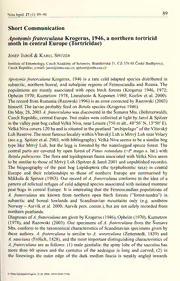
Apotomis Fraterculana Krogerus, 1946, a Northern Tortricid Moth in Central Europe (Tortricidae) PDF
Preview Apotomis Fraterculana Krogerus, 1946, a Northern Tortricid Moth in Central Europe (Tortricidae)
89 Nota lepid. 27 (1): 89-90 Short Communication Apotomisfraterculana Krogerus, 1946, a northern tortricid moth in central Europe (Tortricidae) & Josef Jaros Karel Spitzer Institute ofEntomology, CzechAcademy ofSciences, Branisovskâ 31, CZ-370 05 Ceské Budëjovice, Czech Republic; e-mail:[email protected]; [email protected] Apotomisfraterculana Krogerus, 1946 is a rare cold adapted species distributed in subarctic, northern boreal, and subalpine regions of Fennoscandia and Russia. The populations are mostly associated with open birch forests (Krogerus 1946, 1972; Opheim 1970; Kuznetzov 1978; Linnaluoto & Koponen 1980; Kozlov et al. 2000). The record from Romania (Razowski 1996) is an error corrected by Razowski (2003) himself. The larvae probably feed on Betula species (Krogerus 1946). On May, 28, 2003 A.fraterculana was discovered in the Sumava Mts. (Böhmerwald), Czech Republic, central Europe. Two males were collected at light by Jaros & Spitzer m inthe valleypeatbog calledVelkâNiva, near Lenora (750 alt., 48°50'N, 13°50' E). VelkâNiva covers 120 ha and is situated in the peatland "archipelago" oftheVltavsky LuhReserve. The most famous localitywithinVltavsky Luhis Mrtvy LuhnearVolary (see e.g. Spitzer et al. 2003, with bibliography). Velkâ Niva seems to be a similar bog type like Mrtvy Luh, but the lagg is forested by the waterlogged spruce forest. The central parts are covered by open forest ofPinus rotundata (=P. mugo s. lat.) with Betulapubescens. The flora and lepidopteran fauna associated withVelkâ Niva seem to be similar to those ofMrtvy Lüh (Spitzer & Jaros 2001 and unpublished records). The biogeography of the peat bog Lepidoptera (the tyrphobiontic taxa) in central Europe and their relationships to those of northern Europe are summarised by & Mikkola Spitzer (1983). Our record ofA. fraterculana conforms to the idea of a pattern ofrelictual refuges ofcold adapted species associated with isolated montane peat bogs in central Europe. It is interesting that the Fennoscandian populations of A. fraterculana are known from northern open birch forests ("forest-tundra") in subarctic and boreal lowlands and Scandinavian mountains only (e.g. southern Norway -Aarvik et al. 2000; Aarvik pers. comm.), but are not safely recorded from northern peatlands. Diagnoses ofA.fraterculana are givenby Krogerus (1946), Opheim (1970), Kuznetzov (1978), and Razowski (2003). Our specimens ofA. fraterculana from the Sumava Mts. conform to the taxonomical characteristics ofScandinavian specimens given by these authors. A. fraterculana is similar to A. sororculana (Zetterstedt, 1839) and A. sauciana (Frölich, 1828), and the most important distinguishing characteristics of A.fraterculana are as follows: (1) male genitalia: the spiny lobe ofthe sacculus has more than 60 spines and the cornutus of the aedeagus is long and curved; (2) in the forewings the outer edge of the dark median fascia is weakly angled inwards ©Notalepidopterologica,31.01.2004,ISSN0342-7536 90 Jaros & Spitzer: Apotomisfraterculana incentralEurope to middle (also in A. sauciana) while the outer edge of the dark median fascia is slightly indented and angled outwards, or nearly straight in A. sororculana, in the hindwings the underside in A. fraterculana is lighter compared with that of A. sauciana. The three species occur together in the Velkâ Niva bog, butA. sororcu- lana and A. sauciana are also widely distributed in central and northern Europe. Another similarly cold adapted species ofthe genusApotomis,A. demissana (Kennel, 1900), is recorded from northern Europe only. Acknowledgements We thank Barry Goater, LeifAarvik, and two anonymous referees for comments on our manuscript. Our studies ofpeat bog entomofauna were supported by the Grant ofthe CzechAcademy ofSciences S 5007015. References Aarvik, L., K. Berggren& L. O. Hansen(eds)2000. CatalogusLepidopterorumNorvegiae.-Zoologisk Museum, Universitetet i Oslo. 192pp. Kozlov, M.V, J. Jalava& E. Shutova2000. Newrecords ofLepidopterafromthe KolaPeninsula, north- western Russia. -Entomologica Fennica 11: 131-136. Krogerus, H. 1946. Die finnischen Apotomis-Arten. (Lep. Tortricidae). - Notulae Entomologicae 25: 137-152. Krogerus, H. 1972. The invertebrate fauna ofthe Kilpisjärvi area, Finnish Lapland. 14. Lepidoptera. - Acta Societatispro Fauna etFlora Fennica 80: 189-222. Kuznetzov, V I. 1978. Tortricidae (Olethreutidae, Cochylidae). -In: G. S. Medvedev (ed.), Opredelitel nasekomykh evropeyskoi chasti SSSR [Key to the insects ofthe Europeanpart ofthe USSR] 4(1). -Nauka, Leningrad. -Pp. 193-680. (in Russian). Linnaluoto, E. T. & S. Koponen 1980. Lepidoptera ofUtsjoki, northernmost Finland. - Kevo Notes 5: 1-68. Mikkola, K. & K. Spitzer 1983. Lepidoptera associated with peatlands in central andnorthern Europe: a synthesis. -Nota lepidopterologica 6: 216-229. Opheim, M. 1970. The Norwegian species oftribus Olethreutini Obraztsov, 1946 (Lep., Tortricidae). - Entomologica Scandinavica 1: 241-257. Razowski, J. 1996. Tortricidae. - In: O. Karsholt & J. Razowski (eds), The Lepidoptera of Europe. A Distributional Checklist. -Apollo Books, Stenstrup. -Pp. 130-157. Razowski, J. 2003. Tortricidae (Lepidoptera) ofEurope. Vol. 2, Olethreutinae. - F. Slamka, Bratislava. 301 pp. Spitzer, K. & J. Jaros 2001. Moths and butterflies (Lepidoptera) ofthe Chalupskâ Slat' bog, Sumava Mountains. - Sbornik Jihoceského muzea, Ceské Budëjovice, PfirodniVëdy41: 43-55. Spitzer, K., J. Jaros &A. Bezdëk 2003. Leaf-spinning moths (Lepidoptera) feeding on Vaccinium uliginosum L. along an ecological gradient ofcentral European peat bogs. - Entomologica Fennica 14:46-52.
